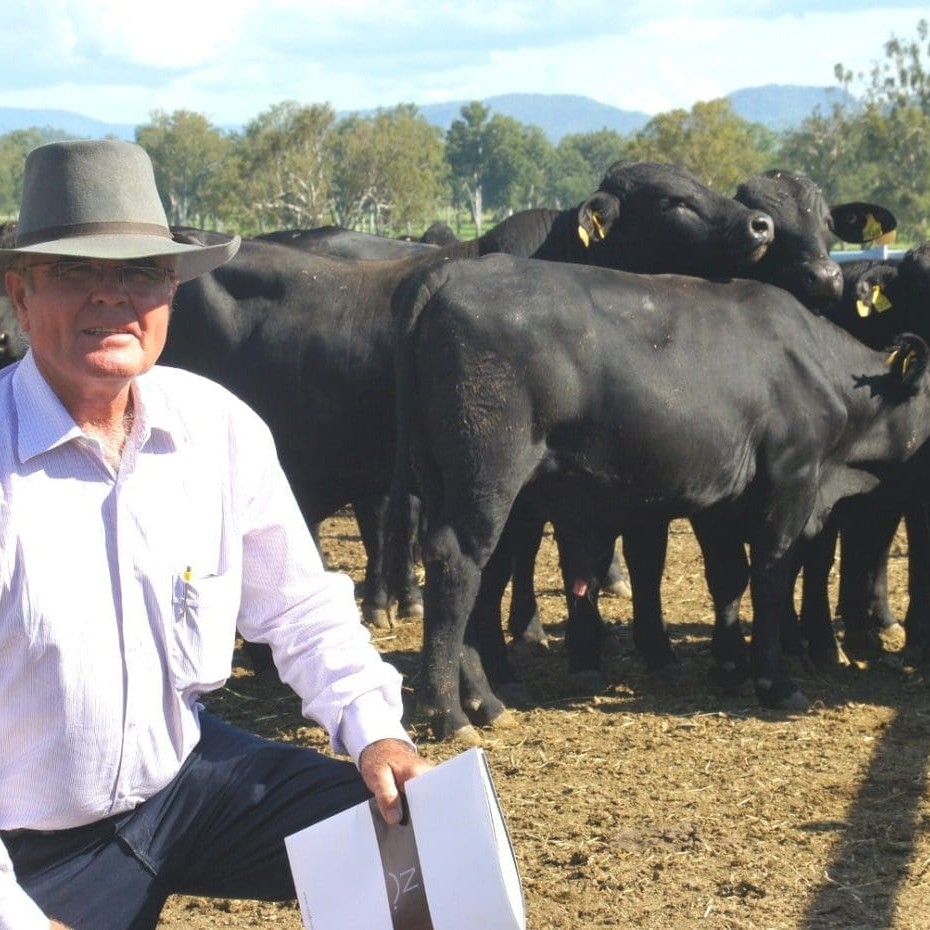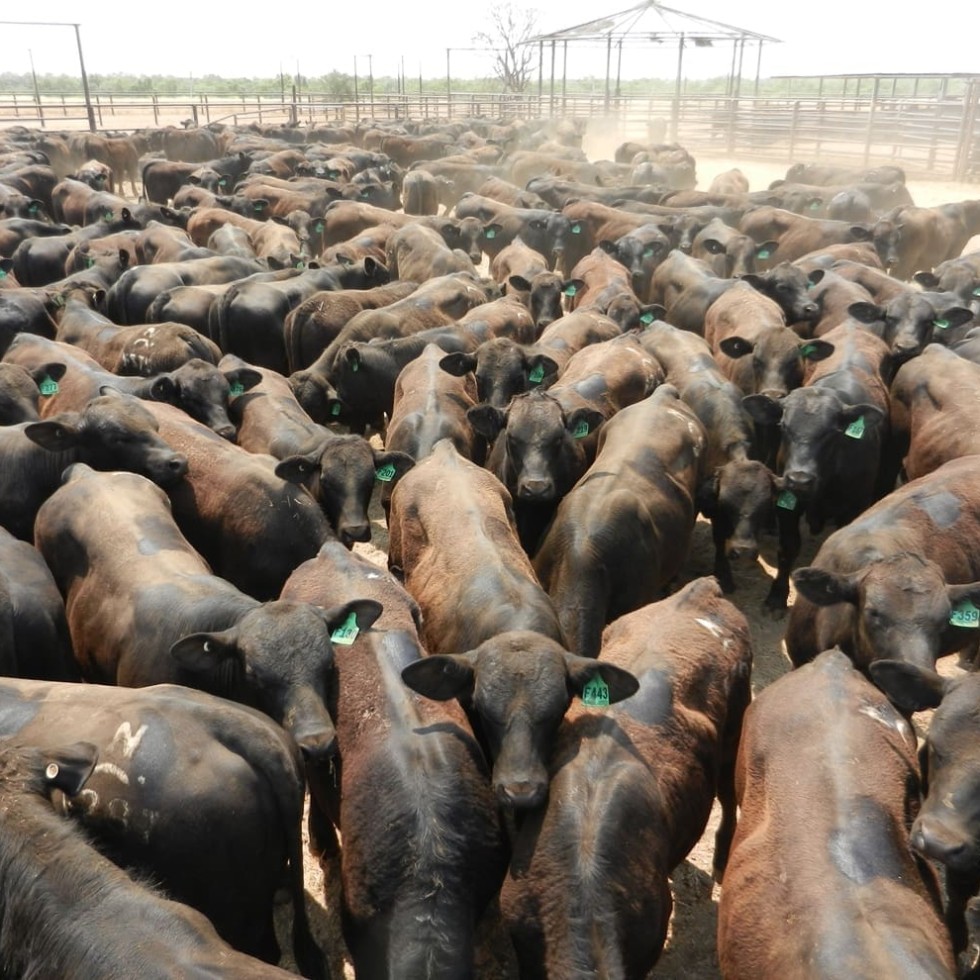 With its genetic building blocks established more than a century ago on Shorthorns, and a second wave of genetic change arriving in the 1970s in the form of Santa Gertrudis, one of the Barkly Tableland’s best-known ‘calf factories’ is now entering its latest generational change.
With its genetic building blocks established more than a century ago on Shorthorns, and a second wave of genetic change arriving in the 1970s in the form of Santa Gertrudis, one of the Barkly Tableland’s best-known ‘calf factories’ is now entering its latest generational change.
Georgina Pastoral Co’s Lake Nash grazing aggregation on the southern end of the Barkly is in transition into a new genetic outcross, using large numbers of UltraBlack, “tropically-adapted Angus” herd bulls.
The move illustrates the emerging trend being seen across live-export exposed regions of northern Australia to adopt genetic packages offering higher meat quality performance with greater flexibility to suit a wider range of markets, from grain and grass-finishing for export, domestic or MSA programs, in addition to live export.
Lake Nash’s original Shorthorn era began in the 1880s with the arrival of pioneering NSW pastoralist John Costello. The second Santa ‘wave’ came 90 years later, with the purchase of the property by King Ranch Australia. King Ranch brought with it Australia’s first Santa genetics from their birthplace on the Kleberg’s ranch near Waco, Texas, and the cattle quickly populated Lake Nash’s breeder paddocks.
But current-day owners, Peter Hughes and family, see Lake Nash’s future as a being built around UltraBlack ‘tropically adapted Angus’ genetics.
The first wave of 250 young UltraBlack bulls arrived on Lake Nash early last year as 14-18 month olds, and were put to work in heifer paddocks. They have been joined by a further 300 in 2012, taking the total UltraBlack sire battery to 550 bulls.
While that sounds like a big number, Georgina Pastoral Co’s entire aggregation across the region – comprising Lake Nash (8487sq km), Georgina Downs (3470sq km) and Argadargada (5139sq km) has a one-time requirement for 2000 herd bulls, meaning the bull generation project still has a considerable way to go.
When Lake Nash was controlled by the AMP-owned Stanbroke Pastoral Co in the early 2000s, it put a lot of Brahman and later composite bulls in the breeding herds, and in the Hughes family era Charbrays had previously been added to the mix, leaving what is basically a Santa/Brahman/Charbray type female carrying about 50pc indicus content.
Attending an open day at the Nindooinbah artificial breeding facility near Beaudesert in southern Queensland earlier this year, Georgina’s Peter Hughes said he saw wide application for the UltraBlack cross calves, the first of which will hit the ground in coming months.
“Even though the feedlot industry has faced difficult circumstances for the past three or four years, we think these calves will be ideal feeder cattle, but also equally suited to growing out as grassfed ox or MSA-type steers,” he said.
“If they don’t go to the feedlot, they will be just as good as bullocks down on the Channel Country (where Georgina operates Keeroongooloo, on Cooper Creek),” he said.
They would also have the right content to make MSA, off country like Georgina’s Caldervale Station near Tambo, which is within ‘striking distance’ of competitive abattoirs under MSA’s transport distance limitations.
Mr Hughes said he rated MSA, and the growing opportunity it now represented, as one of the greatest initiatives to have come into the Australian beef industry during his lifetime.
The big attraction in the application of UltraBlacks on Lake Nash and surrounding company properties was in adding a little more adaption, hybrid vigour and survivability over the straight Angus option.
“While Lake Nash does not carry a tick challenge, it’s a harsh environment, and a little more adaption in the UltraBlack through the splash of Indicus content we think will enable them to get around better,” Mr Hughes said.
Strong maternal attraction
 While carcase merit over the existing genetics in use on Lake Nash was important, the Hughes’s see the maternal side, through greater fertility, and saleability of surplus females as being a big part of the decision to move into UltraBlacks.
While carcase merit over the existing genetics in use on Lake Nash was important, the Hughes’s see the maternal side, through greater fertility, and saleability of surplus females as being a big part of the decision to move into UltraBlacks.
“We see the heifers as being the best part of it,” he said.
While Lake Nash is in reasonably reliable 300mm (12 inch) rainfall country, sometimes it doesn’t rain at all, which is problematic when trying to dispose of females.
And when drought-forced shifts of cattle happen on the Barkly, they happen on an epic scale. In 2008, for example, Lake Nash received just 9mm of rain for the year. That necessitated the uplift of 37,000 head of cattle across the aggregation, either for relocation to other company properties, sent to feedlot, or for sale.
“In that situation, you need very marketable cattle,” Mr Hughes said. “If we again run into a tight seasonal corner, we believe the UltraBlack-based females will be extremely easy to shift, appealing to a much wider buying audience.”
“It gives us an ability to sell those females back into a southern market, which we might not otherwise have with a higher indicus animal, and still get pretty good money out of them.”
The Hughes family is also looking forward to the anticipated fertility improvement through the genetic redirection.
“If genetics can deliver an additional five percent of calves on the ground, we would obviously be very happy,” he said. “Anything more than that and we would be over the moon, but 5pc more calves can make an enormous impact across an extensive breeding operation.”
To put that multiplier effect into some context, Georgina Pastoral’s 17,000sq km of southern Barkly region country last year branded about 27,000 calves. Even an additional 5pc on top of that would account for an additional 1350 weaners.
The Hughes’s have not yet decided how far the UltraBlack genetic imprint will be implanted into the Lake Nash breeding herd, but first cross heifers will certainly be used as breeder replacements.
“We’re not sure whether we will reach the purebred UltraBlack stage. We’ll make those sort of decisions when we get there,” Mr Hughes said.
The first of the calves from the first wave of UltraBlack herd bulls will not be branded until early 2013, after hitting the ground in coming months. That suggests the first round of feeder steers entering the feedyard at Grassdale some time after March 2014, at which time their feedlot and carcase performance will be closely scrutinised.
Breeding high-performance herd bulls on a massive scale
Charged with the responsibility of generating the herd bull requirements for the Lake Nash/Georgina genetics project is Nindooinbah, Australia’s largest artificial breeding centre located near Beaudesert in southeast Queensland.
Nindooinbah produces a range of genotypes including Angus, Brangus and UltraBlacks, using a modern, purpose-built, technically advanced breeding facility delivering large multiples of embryo and AI calves. All are based on elite, heavily-measured genetics.
Since the facility was established in 2006, it has produced more than 10,000 calves through ET and AI programs.
A conception rate over the 26 ET programs to date is above 59pc, and continues to rise. Last year, 1141 embryos were transferred with an average conception rate of 70.25pc.
To put the logistics behind the Nindooinbah breeding programs into some perspective, there were more than 75,000 cattle movements through the facility’s yards last year, and 45,000 cattle movements between paddocks.
For the 2011 year, the facility recorded some 1400 embryo transfers, and used more than 2500 straws of semen.
Much of the work is on a contract breeding basis, with some 4000 head of elite genetics composite cattle having now been custom-produced for the Australian Agricultural Co, alone.
“Our philosophy is to identify the best animals within the breeds with which we are involved through performance recording, genetic evaluation and physical assessment, then to multiply them through world-leading reproductive technologies,” Nindooinbah manager Nick Cameron told an on-property field day audience earlier this year.
The UltraBlack ‘tropically-adapted Angus’ composite, discussed in more detail in this earlier Beef Central article, is seen by clients like Georgina as an ideal balance between carcase quality traits, fertility and adaption, with the retained three-sixteenths Indicus component providing a greater ability to cope with harsher northern grazing conditions than straight Angus.
The genetic building blocks for Nindooinbah’s UltraBlack program were based on the purchase of 650 high-performance Lawsons Angus stud cows, artificially mated to the best performance-recorded carcase and fertility three-eighth Brangus bulls the enterprise could find. The next phase is mating stabilised composite-to-composite.
All of the UltraBlack heifer progeny have been recorded with Angus Breedplan, on the society’s multi-breed register, with a full suite of EBVs for production and meat quality traits. For the UltraBlack heifers these are ‘within-herd’ EBVs at present, but as progeny follow through over the years, they will be directly comparable to Angus Group Breedplan EBVs.
- As part of a catalogue of 110 bulls, Nindooinbah will offer a line of 39 young UltraBlack bulls as part of its inaugural on-property bull sale being staged on October 5, carrying virtually identical genetics to those being employed by Georgina Pastoral Co.



HAVE YOUR SAY